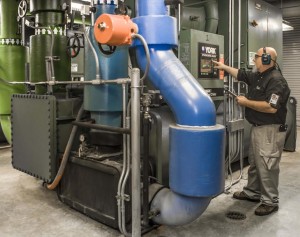
The Chiller Optimization Process
To realize energy savings, the optimization process needs to be well-thought out and thorough. There are three phases to chiller optimization.
Evaluation: The evaluation process covers three phases to determine what can be done to improve efficiency.
- Mechanical infrastructure – First look at the original chiller system design, the original facility requirements and create a baseline of operations. Evaluate the condition of the equipment, how it’s is all connected together and how well it has been maintained. Take measurements for power consumption and process variables, including temperatures, pressures, flow and heat.
- The control system – How is the chiller system being controlled and with what type of control system? Is the instrumentation sufficient and calibrated? Look at the control strategies used for sequencing the equipment and evaluate the temperatures and pressures used.
- Operational evaluation – Look at site-specific issues, such as site limitations or equipment issues forcing a workaround. Also review if operators have been trained and understand the impact of their actions.
Implementation: Recommended actions typically include repairs and changes to the mechanical system, adjustments to the control strategy and operating changes, including operator training.
Measurement and Verification: Verify the proper operations of all the mechanical and control components using testing instruments and existing building management systems. Calculate the system’s operating state; identify failures causing inefficiency. It’s best to collect data over a period of time to determine the best measures to implement.
It’s key to remember that total energy consumption is based on the most efficient system operation, not just the chiller. Beyond maintenance and repair, benchmarking and continual system validation is needed to achieve peak performance.
Benefits of Chiller Optimization
It’s well worth the time invested for chiller optimization. Benefits include reduced energy bills, longer equipment life, less stress on the equipment and delayed capital expenditures.
Chiller Maintenance from Crockett Facilities Services, Inc. HVAC Service Technicians
Crockett Facilities Services, Inc. helps property owners and building engineers save time and money by decreasing utility costs, creating comfortable work environments and enabling our commercial and government customers to focus on their business. We help buildings run better taking a comprehensive approach to improving energy efficiency and occupant comfort.
To learn more about Improving Chiller Efficiency through Optimization Process, please contact Crockett Facilities Services (CFSI) at 202.600.2787 or sales@crockett-facilities.com. We’re in this Building Together!
Like us on Facebook; follow us on LinkedIn, Twitter, and Google+.
Sources:
